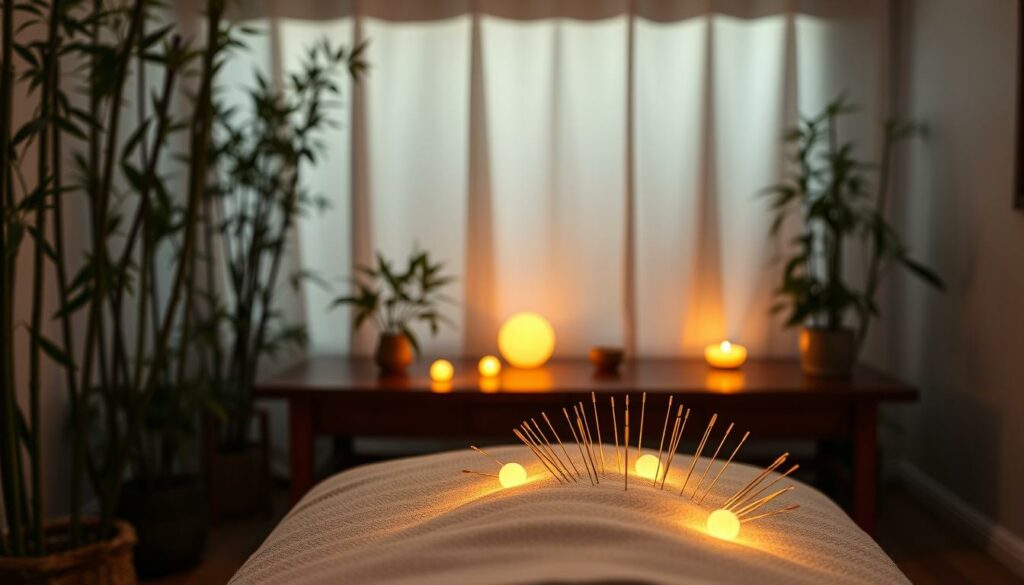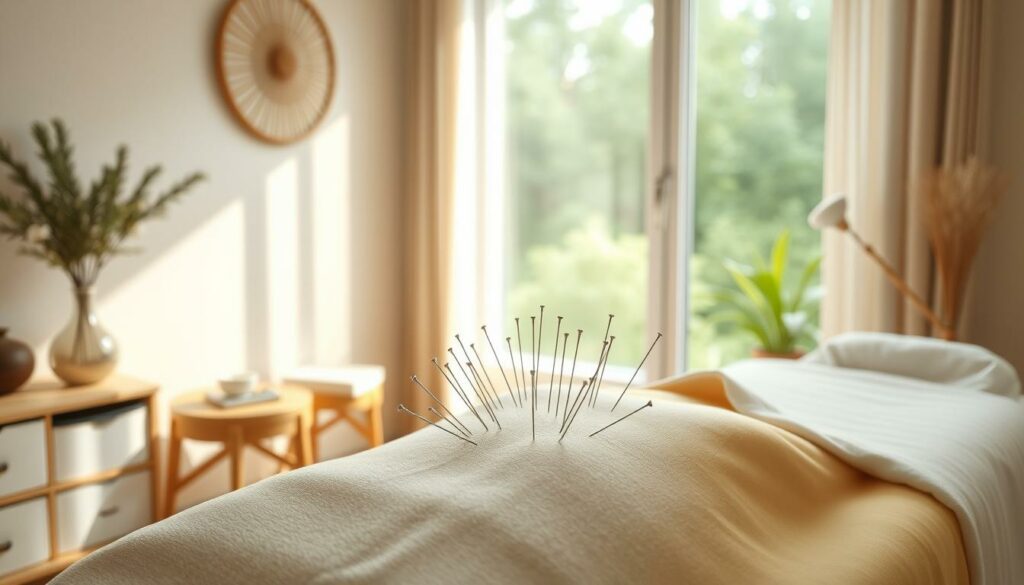In today’s fast-paced world, we often look for ways to get our health back. The path to healing can seem tough, but acupuncture offers a way. It helps us heal not just physically but also emotionally and spiritually.
Acupuncture is more than just a treatment; it’s a way of life. It’s rooted in Traditional Chinese Medicine and can greatly improve our balance and energy.
Key Takeaways
- Acupuncture is one of the fastest-growing fields in integrative health.
- The World Health Organization endorses acupuncture as beneficial for numerous health conditions.
- This practice can effectively address both chronic pain and psychological disorders.
- It promotes holistic healing by balancing physical, emotional, and spiritual health.
- Acupuncture sessions typically last between 45 to 60 minutes, providing a dedicated time for personal care.
- Recent developments allow for better access, with Medicare coverage initiated in 2020.
- Combining acupuncture with other modalities like chiropractic care can enhance treatment outcomes.
Understanding Acupuncture: An Ancient Practice
Acupuncture is seen as a form of alternative medicine with roots in ancient China. It’s a key part of Traditional Chinese Medicine (TCM). TCM helps prevent, diagnose, and treat diseases. It aims to improve overall health and wellness.
There are over 2,000 acupuncture points on the body. Practitioners use these points along meridians to flow energy, or Qi. This helps with various bodily functions.
Research shows acupuncture is effective for many issues. It can help with nausea from surgery or cancer treatments. It also reduces headaches and menstrual cramps.
It’s not just for physical issues. Acupuncture also boosts emotional well-being. It’s effective in managing anxiety and depression, with over 60% success rate.
Acupuncture often comes with other treatments like moxibustion, acupressure, and cupping. These methods add to the treatment’s benefits. Acupuncture is more than just symptom relief. It’s a path to holistic wellness.
The Role of Traditional Chinese Medicine in Acupuncture
Traditional Chinese Medicine (TCM) has been around for over 2,000 years. It focuses on treating and preventing illnesses. At its core is acupuncture, a practice that aims for holistic healing.
Acupuncture works by balancing the body’s vital energy, called Qi. It does this by restoring balance in the body’s energy pathways, or meridians.
In TCM, keeping yin and yang in balance is key for health. Each acupuncture session helps achieve this balance. This helps our bodies heal better.
TCM can help with many health issues, like obesity and diabetes. It also addresses mental health problems. This shows its wide-ranging approach to health.
Acupuncture in TCM has changed how we think about health. Since 1971, it has gained popularity in the U.S. as an alternative treatment. Many people find it helps with pain, improves energy, and boosts overall well-being.
Studies support acupuncture’s benefits in TCM. They show it can help with chronic back pain and improve sleep. These findings highlight acupuncture’s role in TCM, promoting holistic healing.
Acupuncture for Healing: Restoring Energy Balance
Understanding energy balance is key to seeing how acupuncture heals. Our vital energy, Qi, moves through over 2,000 points called meridians. These paths form a complex network. When these paths get blocked, it can cause health problems, affecting our body and mind.

The Concept of Qi and Meridians
In Traditional Chinese Medicine, Qi is seen as a life-sustaining force. It flows through twelve main meridians, with ten linked to organs. When Qi flow is disrupted, we become more prone to illness. Things like pollution, stress, and too much work can block Qi flow.
Acupuncture aims to fix this by using specific points. It helps with issues like headaches, muscle pain, and stomach problems.
Yin and Yang: The Balance of Energies
The ideas of Yin and Yang are vital for our health. Like nature, our bodies need a balance of both for good health. When this balance is off, it can affect our mood and body.
Acupuncture works to balance these energies. By fixing the Yin and Yang, we improve our overall health. This helps us deal better with life’s ups and downs.
Pain Relief Through Acupuncture: What to Expect
Acupuncture is a powerful tool for pain relief. It works by stimulating the central nervous system. This leads to the release of neurotransmitters that help heal and reduce pain.
How Acupuncture Alleviates Pain
A typical acupuncture session lasts 20 to 30 minutes. Hair-thin needles are inserted at specific points on the body. This improves blood flow and reduces inflammation.
Patients often feel relaxed and have more energy. This shows acupuncture not only relieves physical pain but also improves emotional well-being. It’s important to note that acupuncture should not hurt. If it does, the acupuncturist can adjust the needles.
Conditions Commonly Treated with Acupuncture
Acupuncture therapy treats many conditions. Research shows it helps over 30 specific issues, including:
- Low back pain
- Knee pain
- Migraines
- Depression
- Nausea and vomiting
It also helps with allergic rhinitis, hypertension, sciatica, and tennis elbow. While it may not work for fibromyalgia and obesity, many patients find relief. For chronic pain, one to two sessions a week for months are recommended. Acute problems might need eight to ten visits.
Acupuncture is recognized for its versatility. It’s becoming a standard part of healthcare. Many insurance plans now cover it, making it more accessible for those seeking pain relief.
The Mind-Body Connection in Acupuncture Therapy
Acupuncture therapy connects our mental and physical health. It helps us deal with stress and emotional issues that show up in our bodies. By using fMRI scans, research shows acupuncture affects our emotional centers, leading to calmness.
Many people feel relaxed after an acupuncture session. Regular treatments can improve health and life quality. For example, someone with chronic headaches saw a big improvement after four sessions. They also noticed less PMS and cramps the next month.
Acupuncture works by improving qi flow, which helps with circulation. It breaks the cycle of emotional and physical problems. By treating symptoms and imbalances, acupuncture is a powerful healing tool.
| Acupuncture Benefits | Physical Effects | Emotional Effects |
|---|---|---|
| Improved circulation of qi | Reduced muscle tightness | Alleviation of anxiety |
| Enhanced sleep quality | Relief from chronic pain | Better emotional balance |
| Stronger immune response | Improved mood | Reduction of stress hormones |
| Increased energy | Improved digestion | Calming of the nervous system |
These benefits show why we should treat our emotional and physical health together. Regular acupuncture can bring well-being and restore our mind-body connection. This is key for a balanced life and preventing future health issues.
Benefits of Acupuncture: More than Just Pain Relief
Acupuncture does more than just ease pain. It boosts our emotional health and overall well-being. This ancient practice can change our mental and physical health for the better. Its growing popularity shows how it can improve our lives in many ways.
Emotional Well-Being and Stress Reduction
Acupuncture greatly helps with emotional health and stress. Studies show it can lower stress, anxiety, and depression symptoms. It works by releasing endorphins, which make us feel better.
For those facing daily stress or emotional issues, acupuncture offers a helpful solution. It supports emotional healing.
Improved Sleep and Energy Levels
Acupuncture also improves sleep and energy. Many people feel more refreshed and energetic after treatments. It helps fix sleep problems, boosting our daily energy.
Even a few sessions can make a big difference in sleep and energy. This makes acupuncture a great choice for those seeking a holistic approach to wellness.

| Benefit | Description | Evidence |
|---|---|---|
| Emotional Well-Being | Reduces symptoms of stress, anxiety, and depression. | Numerous reports from patients. |
| Stress Reduction | Promotes relaxation and enhances mood. | Studies linking acupuncture to endorphin release. |
| Improved Sleep | Enhances sleep quality and reduces insomnia. | Patient feedback post-treatment. |
| Increased Energy | Boosts overall vitality and energy levels. | Research indicating improvements after sessions. |
Adding acupuncture to our wellness routines can change our lives. It opens us up to better emotional health and stress relief. Plus, it boosts our energy and sleep quality.
Exploring Natural Healing Practices with Acupuncture
Our path to holistic health can be enriched by exploring natural healing practices that go hand in hand with acupuncture. This ancient method, rooted in Traditional Chinese Medicine (TCM), is a powerful tool in our wellness toolkit. It works well with herbal medicine, dietary therapies, and other modalities to boost the effectiveness of our treatment plans.
Acupuncture has a long history, dating back over 2,500 years. Today, more and more people are turning to it as a natural healing method. In the last decade, its popularity in wellness practices has grown by 24%. About 60% of treatment strategies now include acupuncture, mainly for managing chronic pain. This shows a growing trend towards holistic health that focuses on the body’s natural healing abilities.
Adding other natural healing practices to acupuncture can make it even more effective. Here are some examples:
- Herbal Medicine: Using herbs tailored to individual needs can support acupuncture treatments.
- Dietary Therapies: Eating according to TCM principles can help balance our internal health, supporting acupuncture.
- Cupping Therapy: This method helps detoxify and relieve pain, often used with acupuncture for better results.
- Electroacupuncture: This technique uses electrical stimuli to enhance pain relief and healing.
- Moxibustion: Applying heat to specific points treats conditions caused by cold or dampness, offering a targeted solution.
Exploring natural healing practices reveals that many people see a holistic improvement in their health. About 68% of individuals find that acupuncture not only relieves pain but also improves their overall health. These practices invite us to take a comprehensive approach to wellness, addressing both physical and emotional needs.
Choosing the Right Acupuncturist for Your Needs
Choosing the right acupuncturist is key when starting acupuncture therapy. This choice affects our health and well-being. A skilled practitioner can greatly improve our experience.
What to Look for in a Licensed Practitioner
Start by checking if the acupuncturist is licensed. In the U.S., they must meet state requirements. This means they have the right education and training.
It’s also important to ensure they follow hygiene rules. The treatment room should be clean and safe. This includes using sterilized needles and fresh blankets.
Be cautious of red flags like unclean facilities or rushed treatments. Our gut feeling about the practitioner’s professionalism is crucial.
Knowing about different acupuncture styles can help. Each style, like traditional Chinese or Japanese, treats different health issues. Some practices focus on specific areas, like addiction recovery.
Think about the cost too. Prices vary based on location, experience, and style. Check if your insurance covers acupuncture, which can help with costs.
Reviews and referrals are great for finding an acupuncturist. Good communication is key. Ask questions and get clear answers to build trust.
Our happiness with acupuncture depends on the practitioner we choose. Taking time to research can greatly improve our health journey.
Conclusion
Our look into acupuncture for healing shows its great potential for holistic health. This ancient practice, based on Traditional Chinese Medicine, offers many benefits. It helps balance our physical and emotional energies, leading to better well-being and spiritual harmony.
Many in the U.S. have tried acupuncture for natural healing. They’ve found it helps with chronic issues like back pain and migraines. As we learn more about acupuncture, it’s becoming more accepted by healthcare providers and insurers. This makes it easier for people to try it for their health.
Our exploration of acupuncture invites us to see it as more than just a treatment. It’s a key part of a complete health approach. We encourage everyone to try acupuncture. It could improve our lives and help us connect more deeply with our health and wellness.
